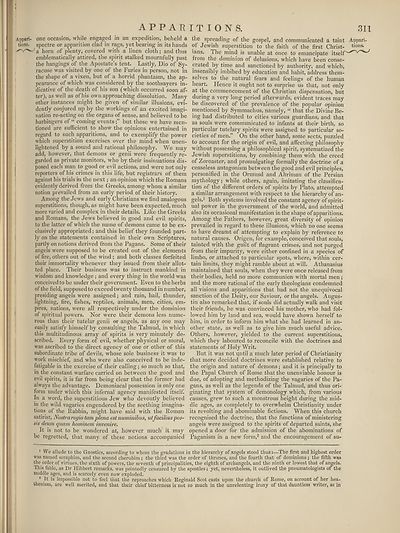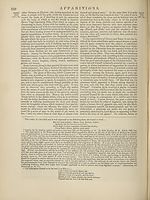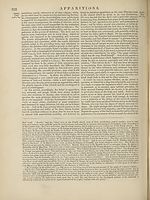Encyclopaedia Britannica > Volume 3, Anatomy-Astronomy
(319) Page 311
Download files
Complete book:
Individual page:
Thumbnail gallery: Grid view | List view

A P P AK
Appari- one occasion, while engaged in an expedition, beheld a
tions. spectre or apparition clad in rags, yet bearing in its hands
a horn of plenty, covered with a linen cloth; and thus
emblematically attired, the spirit stalked mournfully past
the hangings of the Apostate’s tent. Lastly, Dio of Sy¬
racuse was visited by one of the Furies in person, not in
the shape of a vixen, but of a horrid phantasm, the ap¬
pearance of which was considered by the soothsayers in¬
dicative of the death of his son (which occurred soon af¬
ter), as well as of his own approaching dissolution. Many
other instances might be given of similar illusiorts, evi¬
dently conjured up by the workings of an excited imagi¬
nation re-acting on the organs of sense, and believed to be
harbingers of “ coming eventsbut those we have men¬
tioned are sufficient to show the opinions entertained in
regard to such apparitions, and to exemplify the power
which superstition exercises over the mind when unen¬
lightened by a sound and rational philosophjr. We may
add, however, that demons or genii were frequently re¬
garded as private monitors, who by their insinuations” dis¬
posed each man to good or evil actions, and were not only
reporters of his crimes in this life, but registrars of them
against his trials in the next; an opinion which the Romans
evidently derived from the Greeks, among whom a similar
notion prevailed from an early period of their history.
Among the Jews and early Christians we find analogous
superstitions, though, as might have been expected, much
more varied and complex in their details. Like the Greeks
and Romans, the Jews believed in good and evil spirits,
to the latter of which the name of demons came to be ex¬
clusively appropriated; and this belief they founded part¬
ly on the statements contained in their own Scriptures,
partly on notions derived from the Pagans. Some of their
angels were supposed to be created out of the elements
of fire, others out of the wind; and both classes forfeited
their immortality whenever they issued from their allot¬
ted place. Their business was to instruct mankind in
wisdom and knowledge ; and every thing in the world was
conceived to be under their government. Even to the herbs
of the field, supposed to exceed twenty thousand in number,
presiding angels were assigned; and rain, hail, thunder,
lightning, fire, fishes, reptiles, animals, men, cities, em¬
pires, nations, were all respectively under the dominion
of spiritual powers. Nor were their demons less nume¬
rous than their tutelar genii or angels, as any one may
easily satisfy himself by consulting the Talmud, in which
this multitudinous array of spirits is very minutely de¬
scribed. Every form of evil, whether physical or moral,
was ascribed to the direct agency of one or other of this
subordinate tribe of devils, whose sole business it was to
work mischief, and who were also conceived to be inde¬
fatigable in the exercise of their calling; so much so that,
in the constant warfare carried on between the good and
evil spirits, it is far from being clear that the former had
always the advantage. Demoniacal possession is only one
form under which this infernal agency manifested itself.
In a word, the superstitious Jew who devoutly believed
in the wild vagaries engendered by the seething imagina¬
tions of the Rabbin, might have said with the Roman
satirist, Nostraregio tamplena est numinibus, utfaciliuspos-
sis deum quam hominem invenire.
It is not to be wondered at, however much it may
be regretted, that many of these notions accompanied
I T I O N S. 311
the spreading of the gospel, and communicated a taint Appari-
of Jewish superstition to the faith of the first Christ- tions.
ians. The mind is unable at once to emancipate itself
from the dominion of delusions, which have been conse¬
crated by time and sanctioned by authority, and which,
insensibly imbibed by education and habit, address them¬
selves to the natural fears and feelings of the human
heart. Hence it ought not to surprise us that, not only
at the commencement of the Christian dispensation, but
during a very long period afterwards, evident traces may
be discovered of the prevalence of the popular opinion
mentioned by Symmachus, namely, “ that the Divine Be¬
ing had distributed to cities various guardians, and that
as souls were communicated to infants at their birth, so
particular tutelary spirits were assigned to particular so¬
cieties of men.” On the other hand, some sects, puzzled
to account for the origin of evil, and affecting philosophy
without possessing a philosophical spirit, systematized the
Jewish superstitions, by combining them with the creed
of Zoroaster, and promulgating formally the doctrine of a
ceaseless antagonism between the good and evil principles,
personified in the Ormusd and Ahriman of the Persian
mythology; while others, again, imitating the classifica¬
tion of the different orders of spirits by Plato, attempted
a similar arrangement with respect to the hierarchy of an¬
gels.1 Both systems involved the constant agency of spirit¬
ual power in the government of the world, and admitted
also its occasional manifestation in the shape of apparitions.
Among the Fathers, however, great diversity of opinion
prevailed in regard to these illusions, which no one seems
to have dreamt of attempting to explain by reference to
natural causes. Origen, for example, conceived that souls,
tainted with the guilt of flagrant crimes, and not purged
from their impurity, were either confined in a species of
limbo, or attached to particular spots, where, within cer¬
tain limits, they might ramble about at will. Athanasius
maintained that souls, when they were once released from
their bodies, held no more communion with mortal men;
and the more rational of the early theologians condemned
all visions and apparitions that had not the unequivocal
sanction of the Deity, our Saviour, or the angels. Augus¬
tin also remarked that, if souls did actually walk and visit
their friends, he was convinced his mother, who had fol¬
lowed him by land and sea, would have shown herself to
him, in order to inform him what she had learned in an¬
other state, as well as to give him much useful advice.
Others, however, yielded to the current superstitions,
which they laboured to reconcile with the doctrines and
statements of Holy Writ.
But it was not until a much later period of Christianity
that more decided doctrines were established relative to
the origin and nature of demons; and it is principally to
the Papal Church of Rome that the unenviable honour is
due, of adopting and methodizing the vagaries of the Pa¬
gans, as well as the legends of the Talmud, and thus ori¬
ginating that system of demonology which, from various
causes, grew to such a monstrous height during the mid¬
dle ages, as completely to overwhelm Christianity under
its revolting and abominable fictions. When this church
recognised the doctrine, that the functions of ministering
angels were assigned to the spirits of departed saints, she
opened a door for the admission of the abominations of
Paganism in a new form,2 and the encouragement of su-
1 We allude to the Gnostics, according to whom the gradations in the hierarchy of angels stood thus:—The first and highest order
was named seraphim, and the second cherubim ; the third was the order of thrones, and the fourth that of dominions ; the fifth was
the order of virtues, the sixth of powers, the seventh of principalities, the eighth of archangels, and the ninth or lowest that of angels.
1'his fable, as Dr Hibbert remarks, was pointedly censured by the apostles; yet, nevertheless, it outlived the pneumatologists of the
middle ages, and is scarcely even now exploded.
* It is impossible not to feel that the reproaches which Reginald Scot casts upon the church of Rome, on account of her hea¬
thenism, are well merited, and that their chief bitterness is not so much in the unrelenting irony of that dauntless writer, as in
Appari- one occasion, while engaged in an expedition, beheld a
tions. spectre or apparition clad in rags, yet bearing in its hands
a horn of plenty, covered with a linen cloth; and thus
emblematically attired, the spirit stalked mournfully past
the hangings of the Apostate’s tent. Lastly, Dio of Sy¬
racuse was visited by one of the Furies in person, not in
the shape of a vixen, but of a horrid phantasm, the ap¬
pearance of which was considered by the soothsayers in¬
dicative of the death of his son (which occurred soon af¬
ter), as well as of his own approaching dissolution. Many
other instances might be given of similar illusiorts, evi¬
dently conjured up by the workings of an excited imagi¬
nation re-acting on the organs of sense, and believed to be
harbingers of “ coming eventsbut those we have men¬
tioned are sufficient to show the opinions entertained in
regard to such apparitions, and to exemplify the power
which superstition exercises over the mind when unen¬
lightened by a sound and rational philosophjr. We may
add, however, that demons or genii were frequently re¬
garded as private monitors, who by their insinuations” dis¬
posed each man to good or evil actions, and were not only
reporters of his crimes in this life, but registrars of them
against his trials in the next; an opinion which the Romans
evidently derived from the Greeks, among whom a similar
notion prevailed from an early period of their history.
Among the Jews and early Christians we find analogous
superstitions, though, as might have been expected, much
more varied and complex in their details. Like the Greeks
and Romans, the Jews believed in good and evil spirits,
to the latter of which the name of demons came to be ex¬
clusively appropriated; and this belief they founded part¬
ly on the statements contained in their own Scriptures,
partly on notions derived from the Pagans. Some of their
angels were supposed to be created out of the elements
of fire, others out of the wind; and both classes forfeited
their immortality whenever they issued from their allot¬
ted place. Their business was to instruct mankind in
wisdom and knowledge ; and every thing in the world was
conceived to be under their government. Even to the herbs
of the field, supposed to exceed twenty thousand in number,
presiding angels were assigned; and rain, hail, thunder,
lightning, fire, fishes, reptiles, animals, men, cities, em¬
pires, nations, were all respectively under the dominion
of spiritual powers. Nor were their demons less nume¬
rous than their tutelar genii or angels, as any one may
easily satisfy himself by consulting the Talmud, in which
this multitudinous array of spirits is very minutely de¬
scribed. Every form of evil, whether physical or moral,
was ascribed to the direct agency of one or other of this
subordinate tribe of devils, whose sole business it was to
work mischief, and who were also conceived to be inde¬
fatigable in the exercise of their calling; so much so that,
in the constant warfare carried on between the good and
evil spirits, it is far from being clear that the former had
always the advantage. Demoniacal possession is only one
form under which this infernal agency manifested itself.
In a word, the superstitious Jew who devoutly believed
in the wild vagaries engendered by the seething imagina¬
tions of the Rabbin, might have said with the Roman
satirist, Nostraregio tamplena est numinibus, utfaciliuspos-
sis deum quam hominem invenire.
It is not to be wondered at, however much it may
be regretted, that many of these notions accompanied
I T I O N S. 311
the spreading of the gospel, and communicated a taint Appari-
of Jewish superstition to the faith of the first Christ- tions.
ians. The mind is unable at once to emancipate itself
from the dominion of delusions, which have been conse¬
crated by time and sanctioned by authority, and which,
insensibly imbibed by education and habit, address them¬
selves to the natural fears and feelings of the human
heart. Hence it ought not to surprise us that, not only
at the commencement of the Christian dispensation, but
during a very long period afterwards, evident traces may
be discovered of the prevalence of the popular opinion
mentioned by Symmachus, namely, “ that the Divine Be¬
ing had distributed to cities various guardians, and that
as souls were communicated to infants at their birth, so
particular tutelary spirits were assigned to particular so¬
cieties of men.” On the other hand, some sects, puzzled
to account for the origin of evil, and affecting philosophy
without possessing a philosophical spirit, systematized the
Jewish superstitions, by combining them with the creed
of Zoroaster, and promulgating formally the doctrine of a
ceaseless antagonism between the good and evil principles,
personified in the Ormusd and Ahriman of the Persian
mythology; while others, again, imitating the classifica¬
tion of the different orders of spirits by Plato, attempted
a similar arrangement with respect to the hierarchy of an¬
gels.1 Both systems involved the constant agency of spirit¬
ual power in the government of the world, and admitted
also its occasional manifestation in the shape of apparitions.
Among the Fathers, however, great diversity of opinion
prevailed in regard to these illusions, which no one seems
to have dreamt of attempting to explain by reference to
natural causes. Origen, for example, conceived that souls,
tainted with the guilt of flagrant crimes, and not purged
from their impurity, were either confined in a species of
limbo, or attached to particular spots, where, within cer¬
tain limits, they might ramble about at will. Athanasius
maintained that souls, when they were once released from
their bodies, held no more communion with mortal men;
and the more rational of the early theologians condemned
all visions and apparitions that had not the unequivocal
sanction of the Deity, our Saviour, or the angels. Augus¬
tin also remarked that, if souls did actually walk and visit
their friends, he was convinced his mother, who had fol¬
lowed him by land and sea, would have shown herself to
him, in order to inform him what she had learned in an¬
other state, as well as to give him much useful advice.
Others, however, yielded to the current superstitions,
which they laboured to reconcile with the doctrines and
statements of Holy Writ.
But it was not until a much later period of Christianity
that more decided doctrines were established relative to
the origin and nature of demons; and it is principally to
the Papal Church of Rome that the unenviable honour is
due, of adopting and methodizing the vagaries of the Pa¬
gans, as well as the legends of the Talmud, and thus ori¬
ginating that system of demonology which, from various
causes, grew to such a monstrous height during the mid¬
dle ages, as completely to overwhelm Christianity under
its revolting and abominable fictions. When this church
recognised the doctrine, that the functions of ministering
angels were assigned to the spirits of departed saints, she
opened a door for the admission of the abominations of
Paganism in a new form,2 and the encouragement of su-
1 We allude to the Gnostics, according to whom the gradations in the hierarchy of angels stood thus:—The first and highest order
was named seraphim, and the second cherubim ; the third was the order of thrones, and the fourth that of dominions ; the fifth was
the order of virtues, the sixth of powers, the seventh of principalities, the eighth of archangels, and the ninth or lowest that of angels.
1'his fable, as Dr Hibbert remarks, was pointedly censured by the apostles; yet, nevertheless, it outlived the pneumatologists of the
middle ages, and is scarcely even now exploded.
* It is impossible not to feel that the reproaches which Reginald Scot casts upon the church of Rome, on account of her hea¬
thenism, are well merited, and that their chief bitterness is not so much in the unrelenting irony of that dauntless writer, as in
Set display mode to:
![]() Universal Viewer |
Universal Viewer | ![]() Mirador |
Large image | Transcription
Mirador |
Large image | Transcription
Images and transcriptions on this page, including medium image downloads, may be used under the Creative Commons Attribution 4.0 International Licence unless otherwise stated. ![]()
| Encyclopaedia Britannica > Encyclopaedia Britannica > Volume 3, Anatomy-Astronomy > (319) Page 311 |
|---|
| Permanent URL | https://digital.nls.uk/193761495 |
|---|
| Attribution and copyright: |
|
|---|---|
| Shelfmark | EB.16 |
|---|---|
| Description | Ten editions of 'Encyclopaedia Britannica', issued from 1768-1903, in 231 volumes. Originally issued in 100 weekly parts (3 volumes) between 1768 and 1771 by publishers: Colin Macfarquhar and Andrew Bell (Edinburgh); editor: William Smellie: engraver: Andrew Bell. Expanded editions in the 19th century featured more volumes and contributions from leading experts in their fields. Managed and published in Edinburgh up to the 9th edition (25 volumes, from 1875-1889); the 10th edition (1902-1903) re-issued the 9th edition, with 11 supplementary volumes. |
|---|---|
| Additional NLS resources: |
|

